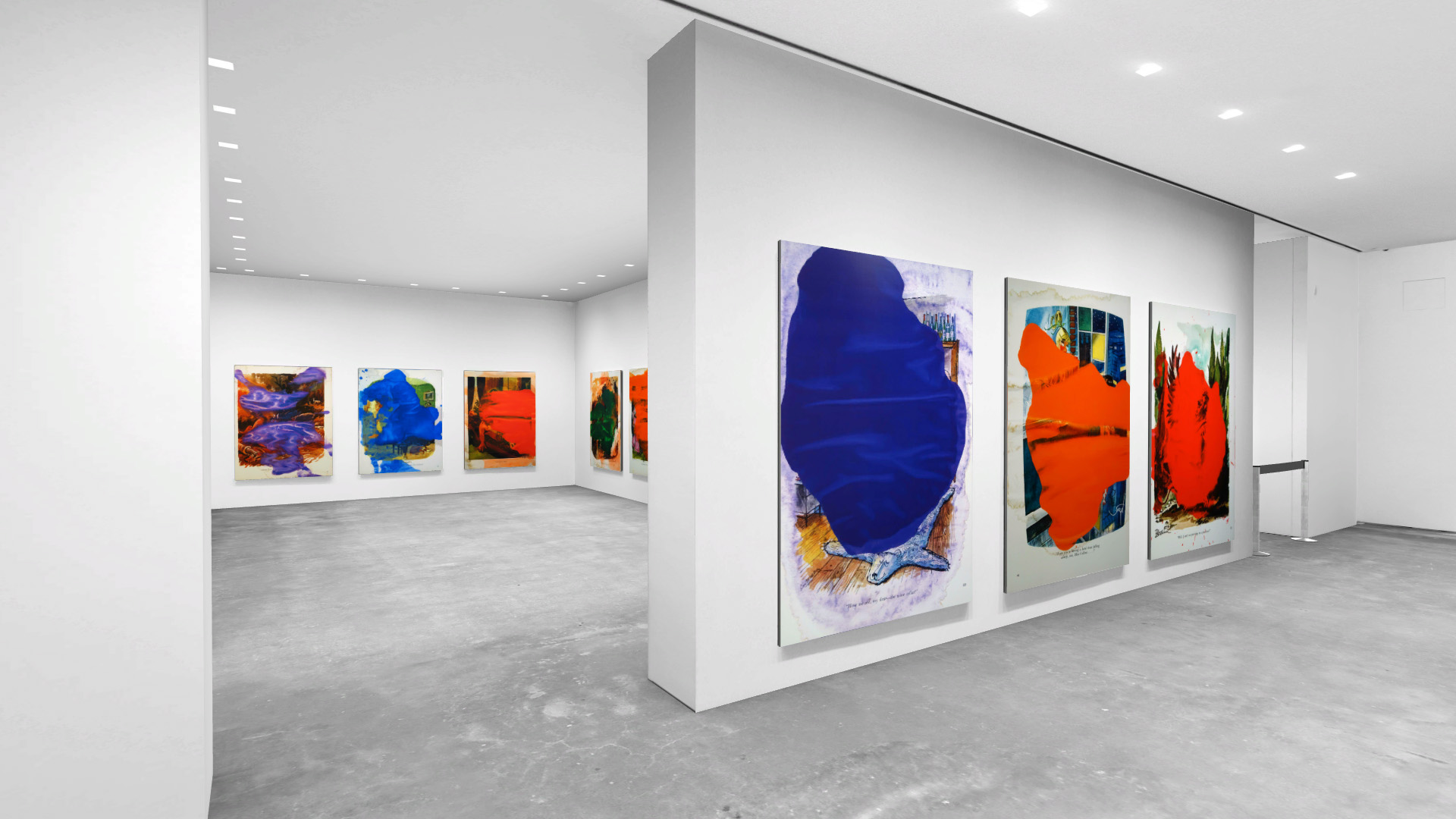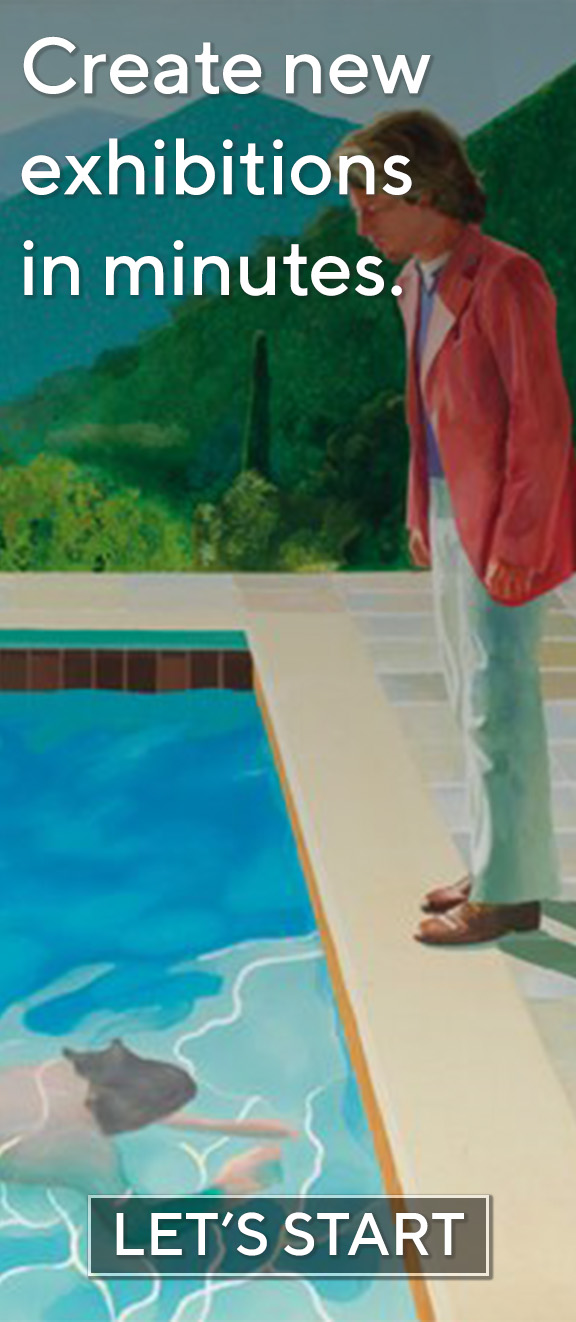

humor over a Whitney Darrow caricature.
Sidebar: Darrow is one of Richard’s “fab’s”. A longtime New Yorker cartoonist. He was also
Jackson Pollock’s roommate.
A little of this. A little of that.
How hard can it be?
The Ripple Paintings are in the middle of two bodies of work.
The first body… Super... more >> Not your everyday semi-realistic preparatory plaster castor fresco with a splash of satiric
humor over a Whitney Darrow caricature.
Sidebar: Darrow is one of Richard’s “fab’s”. A longtime New Yorker cartoonist. He was also
Jackson Pollock’s roommate.
A little of this. A little of that.
How hard can it be?
The Ripple Paintings are in the middle of two bodies of work.
The first body… Super Group. The third body… High Times.
The Ripple Paintings were made between 2015 and 2017.
Richard Prince told me “the rips” started off (“Major Tom’d”), by collecting cartoons published
in Playboy. Cartoons that were originally published between the years 1967 and 1970.
“Three years that I remember, revisit, still think about. The turn on, turn up years. The years the
circle replaced the square. The years the groove moved the twist and the uptight and upright
lost its vote. The years Mr. Jones didn’t know what hit him. These years opened up and let me
out. Man, I felt like I cleaned house. All the phony baloney shot out of my ass. All my life I had
been lied too. Now I was awake. I was receptive. And all I needed was something to agree
with. Between 1967 and 1970 I agreed to say no.”
“I’ve been working on the railroad.”
Richard told me it was a simple idea.
“The cartoons that were submitted to the magazine were watercolors. That’s what was
handed in, delivered to the art director. It was how they were made. Gouache on illustration
board. Sketch, wash, and punch line. I bought the magazines on e-bay. I bought thirty-six
issues. I flipped thru the magazine and tore my favorite “toons” out of the magazine, put the
torn page on the floor, and poured more watercolor on the cartoon. Water on water. My red
watercolor on their yellow cartoon. Fifty/fifty. My contribution? My psychotic breakdown of
my psychic connection. Also a contrasting color. My red water on their yellow water. I would
come back the next morning and my red would dry in its own way. It had personality. Travel,
leak, pool, stains and puddles. And on the way to drying, the dry would ripple the paper. The
pour would do its thing. A secret ‘cover’. The drying stayed up all night. Land of a thousand
dances. The spread of my watercolor really didn’t have to do with me. It was independent. The
form had a life of its own, a mind of its own, and each morning after ‘the evaporation’… I got
a surprise.”
“Trippy.”
I asked Richard if he could pass The Acid Test.
“Probably not.”
“I’ve always been a fan of Ken Kesey. ‘It’s the truth even if it didn’t happen.’ ‘And when you
lose your laugh you lose your footing.’
But I’m late to the Grateful Dead. I just started listening.”
Then he went on a little Birdtalk about the Ripples.
“They’re sexy.
Hit and miss.
Anyone can find me.
Everybody has to listen to Mom.
Balance.org.
Unmasking? Good luck.
Most of the time I don’t have much fun. The rest of the time I don’t have any fun at all.
Que Sera Sera. (I wish)”
Richard kept telling me it was a stupid idea. I’m not even sure he said “idea”. But he did say
“stupid”. He emphasized the word. Like it was a badge. A medal. An award. “You don’t have to
look up the word in the dictionary. If you do, your probably not an artist.” He riffed that like it
was one of his joke paintings.
He liked that his stupid idea lacked common sense. He repeated. Watercolor on watercolor.
“More water. More color?” It wasn’t a question. It was a fact. And Richard likes to have facts in
his works. Non-fiction. Something he can point to and name. He likes his titles to be what
they are. The mistakes are great and he loves making them, but coming up with a name for
the mistakes has to be a bull’s-eye. It’s about helping. “Don’t get mad. Get glad.” Eliminate the
posture. Eliminate the guessing. The speculation. The subjectivity. Richard doesn’t like politics
of symposium.
A second coat of paint.
The jet is nothing but hardware.
Richard knew how he wanted to translate the new covering.
Ink jet.
He’s been using Ink Jet since 1985.
He told me back in ’85 there were only two places in the country you could “send away” for
an ink jet print.
“It was primitive. Four colors sprayed out on a glossy tarp. The interpretation wasn’t very
sophisticated and the reproduction of what you wanted reproduced was usually dull, cheap,
and not very accurate.”
A lot has changed. Now you can have your own machine and instead of sending away to a
commercial lab, you can spend the afternoon typing and coding exactly what you want and
watch what comes out in your own space. Echo. Soul. Emotion. The three ghosts are like
Casper. Friendly. Convenient too. Immediate. No waiting. “No saving up box tops and sending
them off to Battle Creek Michigan.”
“Ancient footprints are everywhere.
You can almost think that you’re seein’ double.
Someday, everything is gonna be smooth like a rhapsody.”
There are all kinds of canvas and paper you can put through the printer, and the way the ink
jets out... is fast, sweet, positive. It’s like some kind of new carburetor blending air and
injecting fuel into a proper ratio. It bursts out a combustion of implausible liquid juice.
“Mine has a Holley and nitrous oxide. It’s a clean machine. It’s not a miracle, but it does the
job.”
“I’ll take my chances.”
“Electronic scissor.”
Richard tells me that’s how he use to describe re-photography back in 1977.
And cartoons?
He’s been dealing with the subject since 1985.
“I wanted something to draw, so I re-drew cartoons.”
“I love cartoons. Funny drawings. Serious humor. Subversive. Laugh out loud. Another way of
surviving. They’re part of the magazine. And I’ve always liked to open up a magazine and see
what’s up. Every magazine is an Inside World.”
Paintings R Us.
After the jet, the canvas is stretched by Kevin from Philadelphia. “He’s the man with the plan.”
This might not mean much, but the image of what’s printed is wrapped around the edge of
the stretcher an eighth inch. It’s not on top, it's around. Not much around, but around. Just
enough. Formalism? Okay. Ingredients matter. But I think Richard would describe it more like
homework. That little 1/8 counts. Without it, the painting is a B-plus. When I went to his studio
to see the paintings, it’s all he would talk about. But he didn’t think it was important to anyone
but him. He’s resigned. He knew that the viewer, the audience... wouldn’t pay attention.
What’s forward and impactful for him is function and pleasure. The combination is in the
details. Discovery takes time. He went on to say, “What’s underneath, the subtext, the “wild
history”… can take years. People are bouncing. That’s what people do these days. The
electric stampede is so jammed up you need to stream Einstein’s pipe to go to sleep. What
can I say? How about the caption in that cartoon?” (He points to a Ripple that’s covered in a
fracture of purple blaze). ‘In dreams begin responsibility.’
Big pieces of color.
That’s what the Ripples are. How do you make a new abstract painting? That’s the last thing I
asked Richard.
“I don’t know,” he said.
“I don’t think that way. How do I make? I go to work. I go to my studio. Shut the door and
listen to Wilco.”
There’s a pause. He looks at his shoes. He lifts one foot off the floor.
“I can only stand this way for so long. After awhile I start to wobble.”
I’m not sure what he means. Then he’s back. Where did he go?
“But yea, abstraction. One thing leads to another. Sometimes I get lucky. Hilma af Klint. She
belonged to the five. A circle of women that tried to get in touch with the high masters. Not
one master but several. Intuition. Alchemy. Séance. We’re talking 1906. Her spiritual non
-objective paintings pre-dated Kandinsky. She ate Kandinsky’s heart out. She died after a
traffic accident. I take that knowing into my studio. I take everything I can get. So of course,
abstraction. The absence of consequences. What do they say?...‘painting the unseen’. So yea.
But I like a good story better.”
Joan Katz
Joan Katz is a journalist, living in Prague, who has known Richard Prince since 1989. In 1990 Prince and Katz formed a band called Black Bra when they were both living in Rome.










